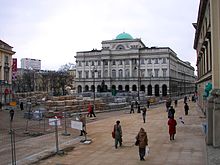Karaś Palace
The Karaś Palace was a late Baroque residence on Krakowskie Przedmieście in Warsaw's inner city district . It was demolished at the beginning of the 20th century and is now a public parking lot.
location
The palace was located on the promenade street Krakowskie Przedmieście, which widened into a small square between Ulica Oboźna and today's Ulica Mikołaja Kopernika and thus opposite the north wing of the Zamoyski Palace, at the transition to Ulica Nowy Świat . The Staszic Palace , which still exists today and was the seat of the Warsaw Society of Friends of Science , stood at right angles to its left . The monument to Nicolaus Copernicus, created by Bertel Thorvaldsen , was located in the small square .
history
Between 1760 and 1772 Kazimierz Karaś had the architect Giacomo Fontana build a splendid late baroque palace with echoes of early classicism on a plot of land given to him by King Stanislaus II August Poniatowski . The facade design is reminiscent of that of the royal palace .
The client died shortly after completion and left the palace to his five children and his second wife, Elżbieta Izabella. As a result, there were inheritance disputes that were decided in court. During the Kościuszko Uprising , the palace served as the seat of Tadeusz Kościuszko's headquarters . Later, among the residents of the house was the well-known beauty Teresa, a daughter of Onufry Kicki, the king's favorite. You should the Prussian Chancellor Karl August von Hardenberg in 1813 on behalf of his King Friedrich Wilhelm III. have offered a morganatic marriage that she rejected .
In the 19th century the building had different owners (including Walewski, Brochocki, Witkowski). The palace became an increasingly shabby tenement with shops on the ground floor. In the 19th century there was a well-known pub "Pod Karasiem" in the house. The editorial offices of the "Gazeta Warszawska" were also temporarily located in the building. In 1905 the businessman Władysław Taubenhaus bought the property. Under him, the palace on its north side was shortened because of the widening of the Ulica Oboźna running here . A window axis and the rounded corner were omitted. He then sold the building to Naftuli Lot and Bronisław Goldfeder, the owners of a railway line.
In 1912 or 1913 the palace was demolished. The real reasons for the demolition are unknown today. The press of the time criticized the demolition, which was allegedly due to dilapidation and danger of collapse. Instead, speculations on the valuable property were suspected. Then a start was made to build a tenement house here. However, the outbreak of World War I ended the construction work. Today there is a parking lot at the location of the palace.
The current user of the Staszic Palace, Polska Akademia Nauk , announced in the 2000s that she was interested in rebuilding the formerly neighboring palace in order to use it herself. The plan was to create conference rooms, guest rooms and an underground parking garage. The mentioned prerequisite was the transfer of ownership of the property by the city authorities. This has not happened so far, also because the question of ownership has not been clarified.
See also
literature
- Olgierd Budrewicz, Przedwczorajsza Warszawa (The Warsaw of Yesteryear) , Verlag BOSZ, ISBN 83-89747-04-9 , Olszanica 2006, p. 84
Web links
- Short info and historical photo at Warszawa1939.pl (in Polish)
- Two new building projects (drawings) by Henryk Gay from 1913 Warszawa1939.pl (vmtl.)
References and comments
- ↑ from: Maria Irena Kwiatkowska and Marek Kwiatkowski, Historia Warszawy XVI-XX wieku - Zabytki mówią , PWN (publishing house), Warsaw 1998
- ↑ Kazimierz Karaś (1711-1775) was a Polish castellan and court marshal of King Stanislaus II August Poniatowski
- ↑ See also the photo of the palace around 1900 at Warszawa1939.pl (under web links ) for the appearance after the renovation
- ↑ According to Jerzy S. Majewski, Krakowskie Przedmieście 2 - pałac Karasia at Gazeta.pl Warszawa from February 5, 2004 (in Polish, for a fee)
Coordinates: 52 ° 14 ′ 17.8 ″ N , 21 ° 1 ′ 6.5 ″ E



